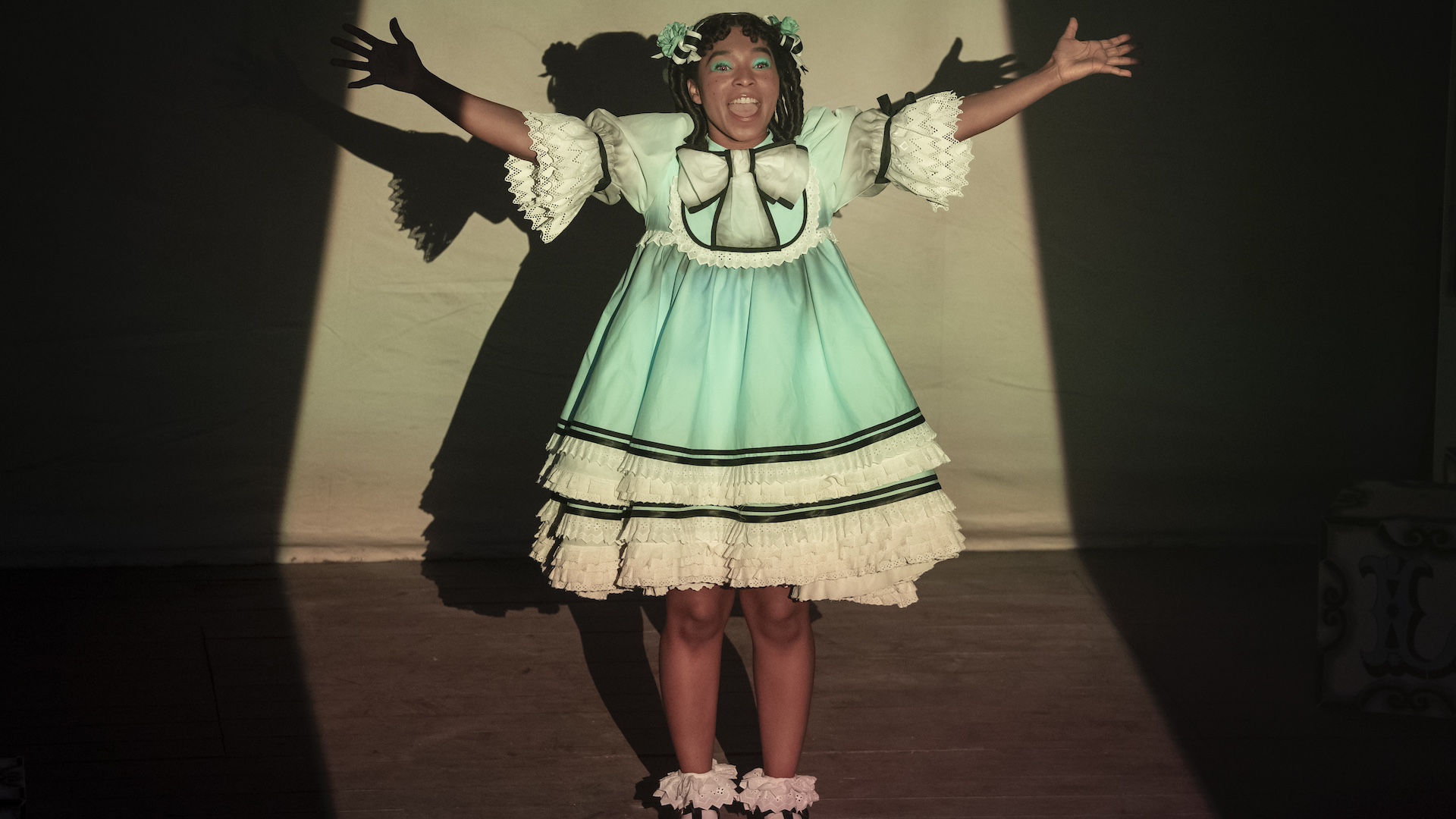
This article contains spoilers for Interview with the Vampire episode 3 and Anne Rice’s VAMPIRE CHRONICLES novels.
Interview with the Vampire episode 3 “No Pain” codifies the Parisian theatrical troupe with signs of sanguinarian cult devotion, and promises of dire consequences. The closing sequence features the ceremony inducting Claudia (Delainey Hayles) into the repertory players of Théâtre des Vampires. It is a giddy moment, for cast members only, and a celebration of the remorselessly debauched comedy made of the lesser creatures in the audience on a nightly basis.
However, there is a serious side to the randomly violent performance arts which is more about occult knowledge than studying acting methods for realistic portrayals. The induction ritual peaks as lead actor Santiago (Ben Daniels) fixes Claudia with the highest drama of theatrical delivery to impart The Great Laws of the Vampire.
“Law One,” Santiago recites. “Each coven must have its leader, and only he might order the working of the Dark Trick upon a mortal. Will you abide?” After Claudia affirms, he continues. “Law Two: The Dark Gifts must never be given to the crippled, the maimed, or to children. No vampire must commit to writing the history of vampires. No vampire shall ever reveal his true nature to a mortal, and let that mortal live. Law Five: No vampire may ever destroy another vampire, except that the coven master has the power of life and death over all his flock. It is his obligation to finally seek the destruction of all who have broken these laws.”
Oops.
Louis de Pointe du Lac (Jacob Anderson), Lestat de Lioncourt (Sam Reid), and Claudia spent the entire first season reveling in the many mockeries to be made of the eternal edicts, and continue to stomp on them with depraved abandon in Paris. To be fair, they are new to this, and the source material could be a little vague to interpret. The Great Laws are not found in Anne Rice’s 1976 book Interview with the Vampire, at least not by any formal name. Nevertheless, the American vampires become well versed in the legal breaches of the European theater.
In the 1976 book, after laughing at troupe member Estelle’s pronouncement that the only cardinal crime is boredom, the trickster vampire Santiago good-naturedly reminisces with the Théâtre des Vampires cast of a “crime for which we would hunt another vampire down until we destroyed him.” Then, while drawing Louis and Claudia into his charismatic bonhomie, pronounces: “It is the crime that means death to any vampire anywhere who commits it. It is to kill your own kind.”
While “The Great Commandments Which All Vampires Must Obey” are expanded on in the 1985 novel The Vampire Lestat and Queen of the Damned (1988), they don’t make much of an impact beyond further self-incrimination. Lestat was told “The Rules of Darkness” were: “To live among the dead, for we are dead things, returning always to one’s own grave or one very nearly like it. To shun the places of light, luring victims away from the company of others to suffer death in unholy and haunted places. And to honor forever the power of God, the crucifix about the neck, the sacraments. And never to enter the house of God, lest he strike you powerless, casting you into hell, ending our reign on earth in Blazing Torment.”
While these appear to conform to the traditional tenets of vampires in literature and other arts, not all of the restrictions ring true, as vampires like Lestat are not harmed by religious iconography. Even Armand, in Interview with the Vampire, admonishes Louis by mocking the very concept: “Children of Satan! Children of God! Is this the only question you bring to me, is this the only power that obsesses you, so that you must make us gods and devils yourself when the only power that exists is inside ourselves? How could you believe in these old fantastical lies, these myths, these emblems of the supernatural?” But Armand was always “a smart, devil-tongued little imp,” according to his maker.
Armand was 17 years old when given the Dark Gift by an ancient vampire named Marius De Romanus, the last of the known Children of the Millennia. Marius lives as an artist in Venice who goes by the title “The Master.” He has been caring for a mysterious group of vampires called “Those Who Must Be Kept” for more than a thousand years. Vampires are “ancient as mankind itself,” Marius tells Armand, who is still called Amadeo after 500 years as a changed creature. “Always here, and always a few, and always warring.”
The ancient edicts evolve during the books. The laws are not fully explained until The Vampire Armand, the sixth book of The Vampire Chronicles. So, Louis, Claudia, and even Lestat may find a little leeway about strict adherence to ancient regulations.
The Five Laws, as laid out by the title character of The Vampire Armand are:
“One, that we were formed in Covens throughout the world, and each Coven would have its leader, and I was destined to be such a one, like unto the Superior of a convent, and that all matters of authority would be in my hands. I and I alone should determine when a new vampire should be made to join us; I and I alone would see to it that the transformation was made in the proper way.
Two, the Dark Gift, for that is what we called it, must never be given to those who were not beautiful, for the enslaving of the beautiful with the Dark Blood was more pleasing to a Just God.
Three, that never should an ancient vampire make the new fledgling, for our powers increase with time and the power of the old ones is too great for the young.
Four, that no one among us can destroy another among us, save the coven leader, who must at any time be prepared to destroy the disobedient of his flock. That all vagabond vampires, belonging to no coven, must be destroyed by that leader on sight.
Five, no vampire must ever reveal his identity or his magical strengths to a mortal and thereafter be let to live. No vampire must ever write any words that reveal these secrets. Indeed, no vampire’s name was ever to be known in the mortal world, and any evidence of our existence which ever escaped into that realm must at all costs be eradicated, along with those who allowed such a terrible violation of God’s will.”
The Great Laws have been in and out of favor since the demise and rise of a Roman coven led by a vampire named Santino since the 13th Century. What appears to be religious respect is actually a way to distance the self-proclaimed Hell-bound blood drinkers from the collective houses of God.
“We are the Children of Darkness,” Santino tells the younger vampire Armand. “We vampires are made to be the scourge of man, as is pestilence. We are part of the trials and tribulations of this world; we drink blood, and we kill for the glory of God who would test his human creatures.”
The Children of Darkness indulge the same sacramental indulgences as the religions they subvert. “There were rituals, there were incantations, there was a folklore of sorts,” declares Santino. “We do not enter churches, for God should strike us dead if we do. We do not look upon the crucifix, and its mere presence on a chain about the neck of a victim is sufficient to save that mortal’s life. We turn our eyes and fingers from the medals of the Virgin. We cower before the images of the saints.”
While these may appear overly oppressive on the surface, the order boasts alluring perks. “We feast when and where we will and with cruelty, and upon the innocent and upon those most blessed with beauty and riches,” Santino points out. “We are a curse of the shadows; we are a secret. We are eternal.”
That’s a sales pitch a vampire can really sink a tooth into. Santino sees in Armand “the pure love of our Savior.” Armand follows the congregation for six months before being sent to Paris, “where the Coven leader has gone, as we all go sooner or later, into the fire,” Santino informs the departing pilgrim. Armand becomes the new leader and saint.
In “No Pain,” directed by Levan Akin, and written by Heather Bellson, Armand (Assad Zaman) sets the date at 1556, when the Roman coven sends him to lead the Paris coven, called the “Children of Darkness,” who lived in squalor within Medieval laws designed to protect them from humanity. Armand claims Lestat was the wind to scatter the failure of his 239-year rule as “Satan’s Fool.” Lestat breaks the rules with impunity upon arrival at the theater. Even Daniel (Eric Bogosian) can’t help but want to meet him.
Anne Rice’s Interview with the Vampire airs Sundays at 9 p.m. ET on AMC and AMC+.
The post Interview with the Vampire Episode 3: What Are the Five Laws of Vampires? appeared first on Den of Geek.







